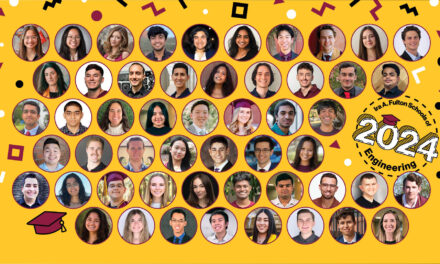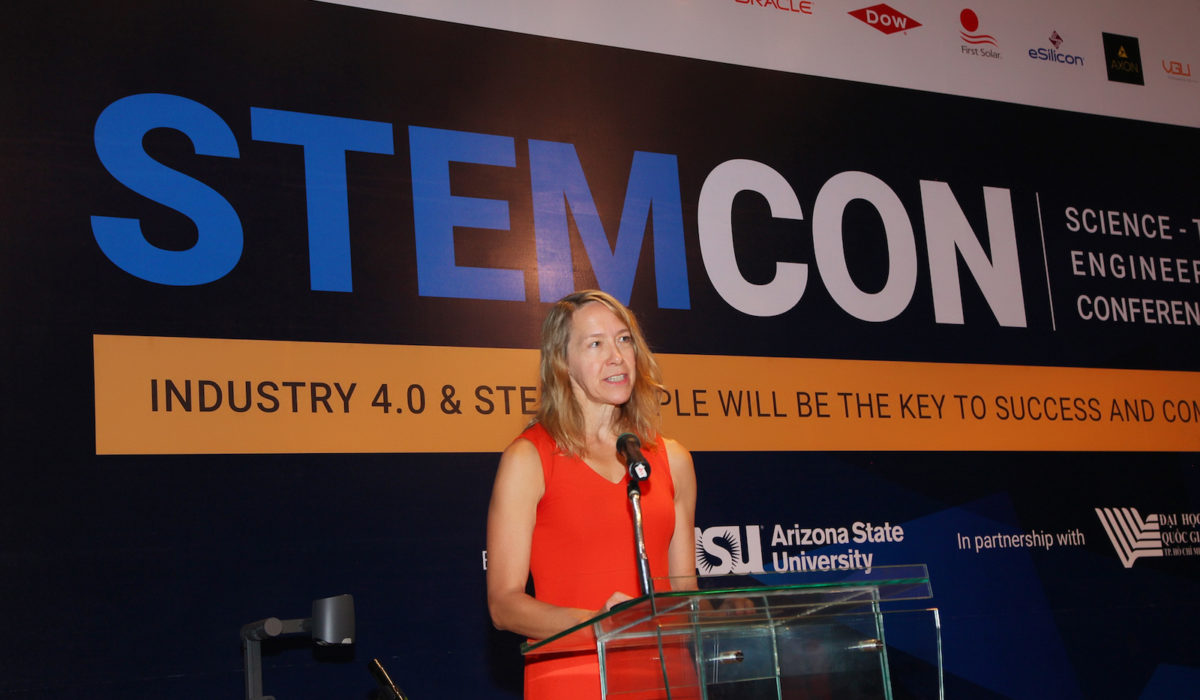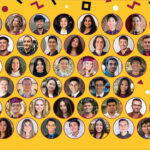
ASU conference primes Southeast Asia to lead Industry 4.0

Above: Khandle Hedrick, lead conference organizer and senior program coordinator in the Office of Global Outreach and Extended Education, speaks with conference participants about their involvement in STEM education in Vietnam. Photographer: Studio Ha Nguyen
This spring, conference delegates from around the globe gathered in Ho Chi Minh City, Vietnam, for STEMCON 2018. Academic, industry and government leaders collaborated, connected and shared best practices that will lead to innovative change in Southeast Asia’s science, technology, engineering and mathematics environment.
Arizona State University partnered with Vietnam National University Ho Chi Minh City to host nearly 600 attendees for the sixth annual conference focused on elevating engineering education and workforce development in the STEM fields.
Through an interactive plenary session, a variety of technical sessions, discussion sessions, seminars and exhibits, participants explored the challenges and opportunities in store as Vietnam prepares to be a leader in Industry 4.0 in the Association of Southeast Asian Networks (ASEAN) region.
During this current wave of the Industrial Revolution — commonly known as Industry 4.0 — manufacturing processes are becoming more digitized, relying increasingly on artificial intelligence, computing power and connectivity to progress from a concept to products. To excel in this area, members of the workforce will need to be proficient in digital technologies, such as automation, data analytics, artificial intelligence, machine learning/robotics, programming, systems integration and software development.
Public-private partnerships, like the Higher Engineering Education Alliance Program (HEEAP) in ASU’s Ira A. Fulton Schools of Engineering, offer opportunities to provide skills training to the existing workforce and students seeking jobs in this rapidly changing field. STEMCON 2018, aptly themed “Industry 4.0 & STEM: People will be the Key to Success and Competitiveness,” offered attendees the opportunity to examine the importance of investing in human capital through education.
“At Arizona State University, we consider ourselves among the most innovative universities in the world. We appreciate the fact that STEM is key to innovation – as are people, obviously,” says Stephanie Lindquist, Deputy Provost and Vice President for Academic Affairs. “We need to intersect technology with people and people skills. We’re very excited that this year we are hosting a conference focused on STEM and Industry 4.0, which is, again, at the cutting edge of innovation in this particular field.”
Conference attendees participated in an interactive plenary by Google executives and technical sessions, panel discussions, seminars and exhibits focused on a range of new biological and digital technologies, including artificial intelligence, robotics, autonomous vehicles, nanotechnology, neurotechnology, quantum computing, smart cities and all things connected to the Internet of Things (IoT).
While STEMCON 2018 offered a wealth of information about technical applications and practical approaches, the primary aim was to connect people with the resources and technology needed to shepherd in the cyber-meets-physical systems approach to manufacturing automation.
See Chong Chan is the managing director for First Solar Vietnam, a leading global provider of comprehensive photovoltaic solar systems. He served on a panel of industry-academic who discussed building an adaptive workforce to compete in Industry 4.0. The broad range of talent and expertise impressed the first-time STEMCON attendee.
“I’m truly amazed by the breadth of topics and also the depth of knowledge that ASU has been able to assemble in its speakers. I’ve gained a lot of insights into the different perspectives from the academia, the industry and also the government.”
Several global companies showed their commitment to develop STEM education in Vietnam by sponsoring scholarships, creating job opportunities and fostering partnerships. Companies included Intel, Amazon Web Services, Axon, Autodesk, Dow, eSilicon, John Wiley & Sons, Microsoft, Oracle, Pearson, Rockwell Automation and Siemens.
“These companies aren’t just sponsoring STEMCON Vietnam,” said Jeffrey Goss, ASU’s Associate Vice Provost for SE Asia and Executive Director of HEEAP and Building University-Industry Learning and Development through Innovation and Technology (BUILD-IT). “They are partnering with Vietnamese STEM educators to develop curriculum and programs designed to prepare the workforce of the future to be technological innovators ready to engage in a global marketplace.”
ASU leads modernization efforts in Vietnam’s STEM higher education system through the development and implementation of HEEAP and BUILD-IT Alliance activities in Vietnam.
Stephen Berlinguette, the USAID Ho Chi Minh City Section Chief stated, “Our work with ASU began under HEEAP in 2010. From 2015, the BUILD-IT Alliance was formed and expanded on some of HEEAP’s great accomplishments. USAID’s goal has remained the same throughout this time: To build a strong public-private alliance of companies, universities and government that transforms higher education and ultimately helps Vietnam address socioeconomic development challenges through STEM skills and technology.
“We are fortunate to have partners who share these goals. Numerous forward-thinking and innovative universities. And ASU itself, with all of the energy, experience and creativity that it brings to the table. We are very proud of all that we have accomplished and will accomplish through this partnership.”
At STEMCON, ideas are born, partnerships are formed and opportunities are created in projects and investments whose impact reaches far beyond the government, industry and academic partners in attendance.
For the past six years, STEMCON has helped ensure that education in Vietnam remains relevant and competitive, especially now as the country shapes itself as a leader in Industry 4.0.



















































